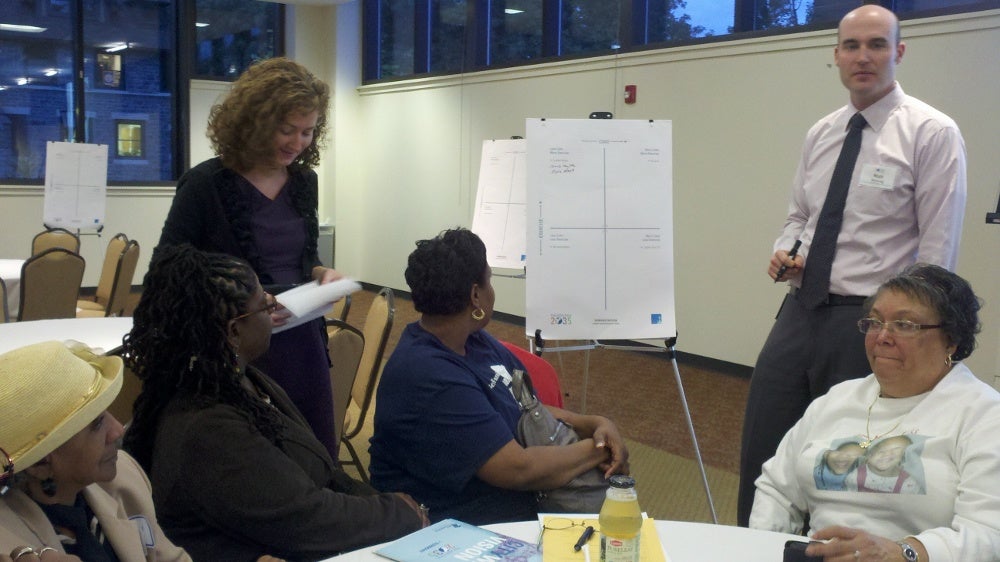A balancing act for West Park neighborhoods
The district-level comprehensive plan for the West Park area will focus on three key areas: Centennial Park, City Line Avenue, and the relatively large amount of vacant properties contained especially in the neighborhoods of East Parkside, West Parkside, and Cathedral Park.
While work continues on the plan – part of the city’s first comprehensive redo in decades – community input and staff research has already highlighted some of the key assets and challenges of the district, community planner Andrew Meloney said at the second public input session at St. Joseph’s University Monday night. Often, the asset and the challenge are directly related.
The West Park district includes residential neighborhoods, a large swath of Fairmount Park, St. Joseph’s University, and the City Line Avenue commercial corridor.
Centennial Park, home to the Phialdelphia Zoo, the Please Touch Museum, the Mann, and other attractions, brings about 1.5 million annual visitors to the district, but planners believe there needs to be more emphasis placed on amenities for people who live nearby. Things like fountains and seating areas would make Centennial more of a neighborhood resource as well, Meloney said.
When visitors come to Centennial Park, they should have restaurants and other services to keep them there for awhile, Meloney said.
“We want to encourage visitors to use public transportation to reduce congestion,” he said.
The City Avenue corridor includes three million feet of office space, and about 28,000 people work there, Meloney said. “We want to encourage more modern office space, and growth on the Philadelphia side of City Avenue,” he said.
Planners want to promote the growth of high-wage jobs, and lessen the area’s automobile dependence.
While the district as a whole has a vacant land rate of 2 percent, it is much higher – 21.3 percent – in Cathedral Park, East Parkside and West Parkside. That translates to 780 vacant lots, or 49 acres. The average home sale price in these three neighborhoods is $37,000, Meloney said. “That is pretty low, and it is pulled down by the proximity of vacant land,” he said.
What’s especially tough, said community planner Jennifer Barr as she led one of the discussion groups, is that the vacant land isn’t in several large chunks, but is scattered.
When it was time for the discussion from which planners will glean more community direction, small groups were asked to weigh regional amenities against local ones at Centennial Park, vehicular traffic vs. pedestrian movement on City Line Avenue, and whether the vacant land in the districts’ neighborhoods should be filled with residences, or other types of development.
The discussion group PlanPhilly sat in on never went for either-or, but instead chose a balanced approach.
Regional attractions at Centennial Park are good for the neighborhood and its businesses, most agreed. “I think you need more attractions,” said West Park community activist Juanita Beverly.
“It’s all good,” agreed Stephanie Rose. “But it doesn’t include the neighborhood, it’s not inclusive.”
“The price is too high for a family with four or five kids,” said Sarah Hall, an Overbrook block captain who enjoys taking her grandchildren to the Please Touch Museum on the monthly reduced-fee-for residents day. The Zoo could use one of those, she said. The group liked the idea of more fountains and seating areas, but offered the advice that all amenities be well-lit for safety.
Long-time resident Ernestine Clemons was surprised and very pleased to learn that most of what is now Centennial Park was built for the Centennial Exhibition that marked the 100th anniversary of the signing of the Declaration of Independence. That history should be played up, she said.
Barr asked if residents thought Centennial Park would make a good spot for another world’s fair. The most common response was a variation of: “So long as no one drives here.” It was a joke of sorts, but participants seriously came back again and again to traffic and parking issues in the area, particularly on busy zoo days or when there are concerts at the Mann.
When asked to consider vehicular traffic and pedestrians on City Line Avenue, and what could solve movement problems for everyone there, everyone seemed to agree that City Line is a hard place to walk or drive, but didn’t know of anything that could really fix it – particularly without hurting the businesses that line the corridor.
Some said they would like more buses on the road. If cars were downplayed, the businesses would need to change, they said, as many now are restaurants with drive-thrus or large retail stores with equally large parking lots. St. Joe’s students would likely always patronize whatever is on the avenue, they said.
Joan Wright, who has lived near the avenue for 44 years, said she used to feel safe walking along the roadway, but there are now too many cars. She doesn’t see that changing. “People are going to drive, no matter what,” she said.
Rose asked for a bicycle lane “that makes you feel safe.”
Participants said some of the vacant lots should definitely be used for housing, and that the homes should be owner-occupied and sold at different price points so that people with varying incomes live in the same neighborhood.
The homes should look and be styled like their neighbors’ properties, but should be built with green technology, they said.
But residents have many other ideas for vacant lots, including farmers’ markets, community gardens and community centers.
Beverly said produce could both be grown and sold on such lots, and neighborhood children could learn entrepreneurial skills there.
The final West Park meeting has not been scheduled, but it will take place in November.
Reach the reporter at kgates@planphilly.com.
WHYY is your source for fact-based, in-depth journalism and information. As a nonprofit organization, we rely on financial support from readers like you. Please give today.




